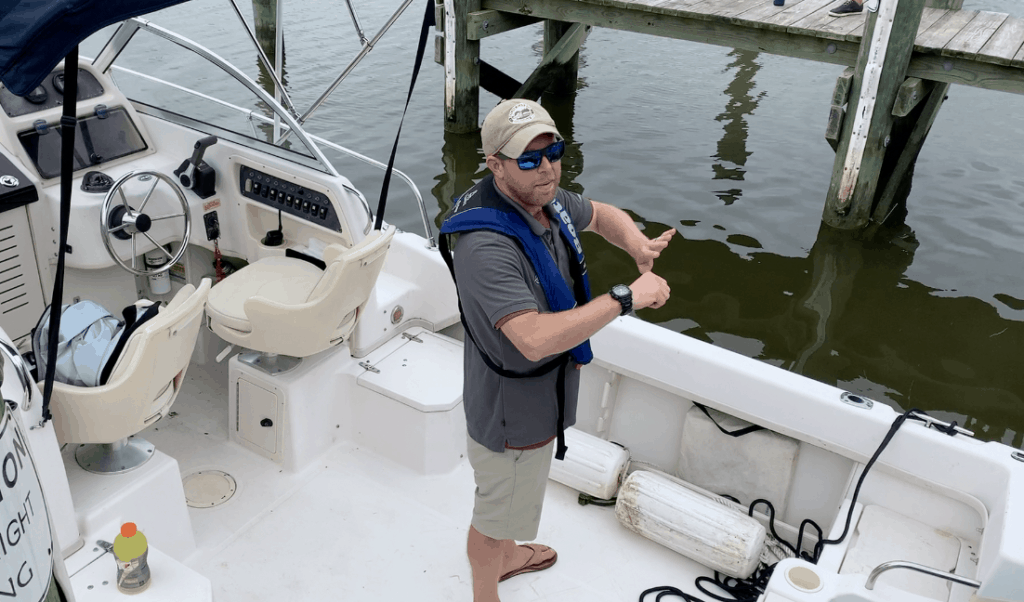Free Boating Clinics Offered at Sandy Point

Photo by Cheryl Costello.
By Cheryl Costello
There are plenty of new boaters out on the Bay, if you hadn’t noticed all those vessels flying off the shelves from local dealers and brokerages. It’s great news for the pastime we love in Chesapeake Country, but it also means a lot of boaters are looking to boost their skills and confidence on board. A series of “Welcome to Boating” clinics—offered for free through a partnership in Maryland—aims to make sure folks know their way around a boat before they dive in headfirst.
The Marine Trades Association of Maryland is leading the charge on these informative sessions. Executive Director Susan Zellers says the timing is right. “We saw a 12 percent increase nationally in boat sales [this year],” Zellers says.
Pandemic boat buying prompted a crowd to come out to Sandy Point last Friday and learn the ropes—er, lines.
Captain Matt Benhoff, from our sister company, the Annapolis School of Seamanship, demonstrated docking techniques. The approach should be different based on the weather and the boat you’re driving, Benhoff says. At last Friday’s session, he showed one scenario. “I’m coming in from a smaller angle because the wind is coming from that direction. Nice and slow—I’m in neutral coming in toward the dock. Remember, neutral is a gear, too…” Benhoff explained to the crowd watching from the dock.
Cathy McDuffie traveled from Forestville to the clinic. She’s been boating for years, but wanted to work more on line handling. “That’s always been an issue,” she said, “when you throw someone the rope or someone throws me the rope because I’m holding it…that can be scary. If the driver puts the boat in drive, it pulls.”
Safety can’t be overlooked either. The BoatUS Foundation showed inflatable life jackets that puff up with the just the pull of a tab. “It only has the potential to save your life if you’re actually wearing it. You know they’re required to be aboard every boat and they need to be readily accessible, but if you are wearing it you know exactly where it is aboard,” pointed out Ted Sensenbrenner, BoatUS Foundation’s director of boating safety.
Kimberly Nelson and her father, of Annapolis, who also attended the clinic, plan to buy a boat in the next several weeks. They’re putting the learning before the buying. “We want to make sure we know A) what we’re getting into and B), have everything we need to, and then C), make sure we feel comfortable once we get out there,” Nelson told Bay Bulletin.
It’s a federal and state requirement to have flares aboard and up to date. Taking your time when gassing up should be a consideration, says Leigh Diemert, general manager of Oasis Marinas inAnnapolis. “Take your time. It’s like a chore to fuel up, so it’s really just slowing down and making sure that process is safe.”
Benhoff cautioned that the technology available on newer boats can give beginner boaters a false sense of security. “The GPS can’t tell you if there are other boats out there; if there’s something in front of you,” he says. “During daytime, it should be about 90 percent looking out in front of you and about 10 percent looking down at your navigation.”
In all aspects of boating, practice is key, Benhoff says. “I feel comfortable docking, but that’s because it too me a long time getting there. I bounced off plenty of docks getting there,” he says with a chuckle.
Marine Trades Association has offered the new boaters clinic three times, and Chesapeake Bay Media is a proud sponsor. The program is expected to come back next year, too.
“From our standpoint, we want to keep them boating,” says Zellers. So if we can teach them those things and make them feel confident, then we think they’ll own five boats before they’re done boating. But if we don’t do that and we leave them to flounder and not know what they’re doing, then they’re going to be miserable.”
And who wants to be miserable while relaxing on the water?
